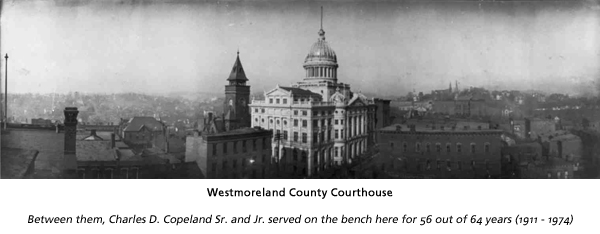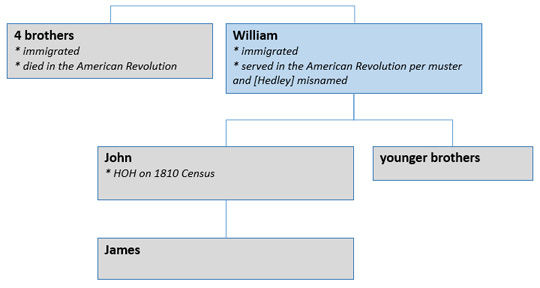
This site is a collation of descendants of John or William Copeland of Pennsylvania and, presumably, Ireland.
The information comes from various Copeland descendants, both in my line and others.
The Copelands are a difficult family to trace. The family is Irish and the majority of Copeland surnames were in Ulster 250 years ago. Edward Neafsey's The Surnames of Ireland: Origins and Numbers of Selected Irish Surnames says, "The name is very much concentrated in and around Belfast and in the Ards peninsula." [Hedley] says the following about their origin in America:
John Copeland...came from Ireland shortly before the Revolutionary War, and was one of the first settlers of that part of Sewickley township which now embraces South Huntingdon township. He and his four brothers fought with the Continental Army in that early struggle with England, and he was the only one of the five to survive the war.He married a Miss Martin, of Sewickley township. Among other children born to this union was John Copeland, who married Nancy McGrew, of the same township. One of the children of John and Nancy (McGrew) Copeland was James Copeland...
The story may be true but these family history compilations often relied on family anecdote rather than documentation. In our case, a typed family tree and handwritten notes listing this information were found among Copeland papers but there is no indication if these were based upon [Hedley] or vice-versa. Either way there are some difficulties with the story.
The primary problem is finding a matching John Copeland in the American Revolution. The only recorded veteran of that name from Pennsylvania was Captain Jonathan Copeland. However, he died in 1786 in Philadelphia, leaving behind daughters. There are other John or Jonathan Copelands in the service but they lived in the Carolinas and New England. Furthermore, there appears to be no collection of five Copelands mustering in anywhere in America. Of the few Copeland/Coplin/Cowpland surnames we find from Pennsylvania, some are English by birth and all are geographically scattered from Philadelphia to Mifflin Co. to Allegheny Co., casting doubt on their being Irish siblings who enlisted together.
The second difficulty is John's age. We find a John Copeland on the 1810 Census of North Huntingdon Twp. and, although he is elusive for a number of years, the 1850 Census seems to indicate he is our John. He is between 26 and 44 years of age in 1810 which means his earliest birth date was 1766, assuming no census error. That would have made him 10 at the start of hostilities and 15 by the Battle of Yorktown, which was the effective end of the war. The minimum age of enlistment was 15 with parental consent and 16 without it so he would have had to lie about his age to join.
The third difficulty is that we find a William Copeland living in North Huntingdon on the 1790 Census who shows on the muster rolls of the American Revolution and all of the Copelands in the town appear to be in his household.
Finally, the Daughters of the American Revolution show this William Copeland as Pennsylvania-born rather than Irish-born and, presumably, all his children would be, as well. There's no indication that I've seen for where this assertion comes from and we might choose to discount it.
There are several possibilities to account for these issues, none of them perfect. In the following, the first John mentioned in [Hedley] is referred to as John Sr. and the second as John Jr. In the illustrations, the individual associated with that ancestor who was a veteran is marked in blue.
Theory #1: the story is true as told
The John of the 1810 Census is John Sr. and, while nominally too young to have served, he did so and was missed on the compilations of muster rolls. William was his father.
We would have to interpret "one of the first settlers" in [Hedley] as not implying he was the head of household since he is, presumably, in William's household in 1790. Further, we have to presume that [Hedley] is not stating that the four brothers who died were the only brothers—though perhaps the only ones born in Ireland—since John appears to have other brothers later. Finally, we have to wonder how [Hedley] missed John's father's participation in the war.
In order for this to work, we'd have to assume that John Sr. was born toward the beginning of the range allowed by the 1810 Census in order to allow for the correct number of generations. I believe the latest birth year for James Copeland is 1810, a range of 44 years from 1766. That's enough time to squeeze John Jr. in between.
It would result in something like the following:

The problem is the lack of an appropriate John Copeland on the muster rolls, or any clustering of Copeland enlistments. We also have a problem with the John on the 1850 Census as he is too young to be John Sr. and seemingly too old to be John Jr. For the latter to be true, John Sr. would have been a father at 14.
Theory #2: the family story missed mentioning a generation
We could presume a much older John Sr., born in Ireland, who was the immigrant with several brothers and fought in the Revolution. He had children with a Miss Martin in Pennsylvania and one of those children, William, also fought. In this theory, John has passed away by 1790, leaving William as head of household. The John of 1810 is John Jr.
It would result in something like the following:

Again, the problem is the lack of an appropriate John Copeland on the muster rolls. The 1850 John is still problematic, although somewhat less so since we just have to move a birth by a few years rather than move it plus postulate 14-year-old fathers.
Theory #3: John was really William
We have William Copeland who: a) is documented as serving in the American Revolution, b) was known to have a son named John, and c) shows up on the census record as an early settler of Huntingdon. If family lore mis-remembered the name and John Sr. was really named William then this becomes a reasonable fit. John on the 1810 Census becomes the person we've been calling John Jr. but is now the only John.
This would look something like:

The problem here is from a family history perspective not a census perspective: William is believed to have married Jane Parkinson, while family story has it that John Sr. married Miss Martin.
The lack of a John Copeland in the muster lists weighs heavily with me, so I favor the final explanation and have organized this family tree around it:
- William is the veteran of the American Revolution, not John, although his name may have been William John or John William for all we know.
- John Jr. of family story is the John of the 1810 Census.
- William was likely of Irish descent although whether he was born there or not is uncertain.